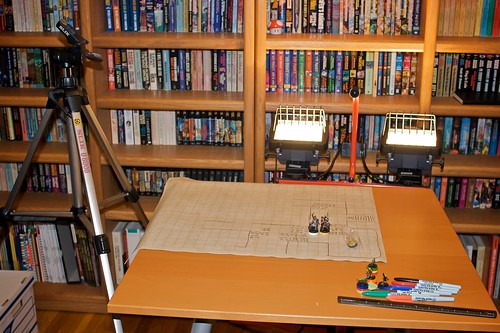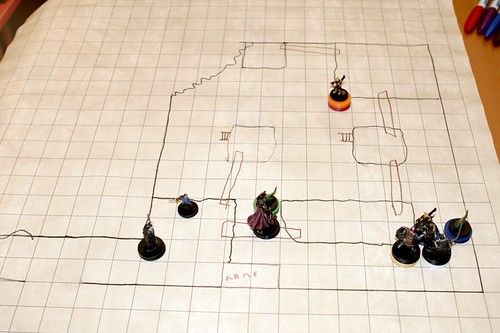I left last week's D&D session set up on the table until I got a chance to take some photographs. I'm amused to talk about the process I use to play online and there are a couple of photo enthusiasts who read the blog who might well comment on improving the setup.
First off, what the what? There's a long story behind this but the key bit is that I'm running a Dungeons & Dragons campaign online. We use Skype for voice chat, and I have this moderately janky Ruby on Rails application I threw together to display pictures to the players. I pop my camera up on a tripod and point it at miniatures and upload the pictures, thus giving us an online approximation of gathering around the table and playing.
OK. So given that as background I was surprised at the amount of inconsistency I was getting from the pictures. On different nights the camera would focus on weird areas of the map, as I tried different camera angles I'd get different results, it's been a difficult process. I finally got a process I'm pretty happy with but I'm happy to hear suggestions for improvement.
A lot of it is pretty ghetto. You can see my cheap-ass tripod that is supposed to be for Karin to have at school but I sort of stole. (Not to say it's school property's - it's Karin's but it lives in my office most of the time now.) I don't have a separate off-camera flash, or a stand and a nice diffusion umbrella and all - I have a halogen work light with two independent bulbs. The camera is my Canon Rebel XTi and I use a 28mm prime lens (which given the Canon crop factor works out to the effective crop of a 45mm lens). I've screwed with the lighting a lot and the thing that seems to work best is to point both halogen lights straight up and bounce them off the ceiling. I had been pointing one sideways as a fill light but that makes some really odd shadows on the miniatures. I let the camera use its flash for some fill.
Normally I shoot in RAW mode, but for these shots I need a JPG and processing time is a concern so I just shoot JPG (the large and "unsmoothed" images since I can process them later and use better sharpening filters and the like). I usually put the camera in the A-DEP mode which tells the camera to maximize depth of field. I've left everything else on the "do what you think is best" sort of switches - so auto white balance and the like. ISO is set at 800.
OK, enough babble. Here's the basic setup:

In this shot the only lighting is the halogens you see and the flash of the camera itself. Oh, and there's a polarizing filter on the lens. Of course, normally the camera is on the tripod, but you get the idea. This was the real actual geometry I used in the last session, I just popped the camera off the tripod to shoot this.
Here's a closer shot of the mat. The mat is "wet erase" which means I can draw on it with "Vis a Vis" markers - you can see those at the edge of the shot:

So what does this ultimately yield? Well I have an Automator action that tells the camera software to take a picture. Then it asks me to find the picture on the hard drive, passes it off to Pixelmator which does an "Auto Enhance" which adjusts the levels. Pixelmator also resizes to a 1023 pixel wide image (not sure how I picked that size, but it's what I use). Then it uploads the file to a public folder on the net and asks me for a description of the image. Finally it sends a special URL to the Rails application causing an update with the new picture and description and javascript on all the player's browsers fetches the new data automatically.
Here's an actual example from last week's session, plucked straight from the web application:

So, like I said it works pretty well. But if anybody has any suggestions I'd love to hear them. While I think having photographic lighting would be a big win so far I've been hard pressed to say what else I'd use it for. I don't do posed portraits so I'd be buying lighting equipment just for D&D, which seems ridiculous.
First off, what the what? There's a long story behind this but the key bit is that I'm running a Dungeons & Dragons campaign online. We use Skype for voice chat, and I have this moderately janky Ruby on Rails application I threw together to display pictures to the players. I pop my camera up on a tripod and point it at miniatures and upload the pictures, thus giving us an online approximation of gathering around the table and playing.
OK. So given that as background I was surprised at the amount of inconsistency I was getting from the pictures. On different nights the camera would focus on weird areas of the map, as I tried different camera angles I'd get different results, it's been a difficult process. I finally got a process I'm pretty happy with but I'm happy to hear suggestions for improvement.
A lot of it is pretty ghetto. You can see my cheap-ass tripod that is supposed to be for Karin to have at school but I sort of stole. (Not to say it's school property's - it's Karin's but it lives in my office most of the time now.) I don't have a separate off-camera flash, or a stand and a nice diffusion umbrella and all - I have a halogen work light with two independent bulbs. The camera is my Canon Rebel XTi and I use a 28mm prime lens (which given the Canon crop factor works out to the effective crop of a 45mm lens). I've screwed with the lighting a lot and the thing that seems to work best is to point both halogen lights straight up and bounce them off the ceiling. I had been pointing one sideways as a fill light but that makes some really odd shadows on the miniatures. I let the camera use its flash for some fill.
Normally I shoot in RAW mode, but for these shots I need a JPG and processing time is a concern so I just shoot JPG (the large and "unsmoothed" images since I can process them later and use better sharpening filters and the like). I usually put the camera in the A-DEP mode which tells the camera to maximize depth of field. I've left everything else on the "do what you think is best" sort of switches - so auto white balance and the like. ISO is set at 800.
OK, enough babble. Here's the basic setup:

In this shot the only lighting is the halogens you see and the flash of the camera itself. Oh, and there's a polarizing filter on the lens. Of course, normally the camera is on the tripod, but you get the idea. This was the real actual geometry I used in the last session, I just popped the camera off the tripod to shoot this.
Here's a closer shot of the mat. The mat is "wet erase" which means I can draw on it with "Vis a Vis" markers - you can see those at the edge of the shot:

So what does this ultimately yield? Well I have an Automator action that tells the camera software to take a picture. Then it asks me to find the picture on the hard drive, passes it off to Pixelmator which does an "Auto Enhance" which adjusts the levels. Pixelmator also resizes to a 1023 pixel wide image (not sure how I picked that size, but it's what I use). Then it uploads the file to a public folder on the net and asks me for a description of the image. Finally it sends a special URL to the Rails application causing an update with the new picture and description and javascript on all the player's browsers fetches the new data automatically.
Here's an actual example from last week's session, plucked straight from the web application:

So, like I said it works pretty well. But if anybody has any suggestions I'd love to hear them. While I think having photographic lighting would be a big win so far I've been hard pressed to say what else I'd use it for. I don't do posed portraits so I'd be buying lighting equipment just for D&D, which seems ridiculous.